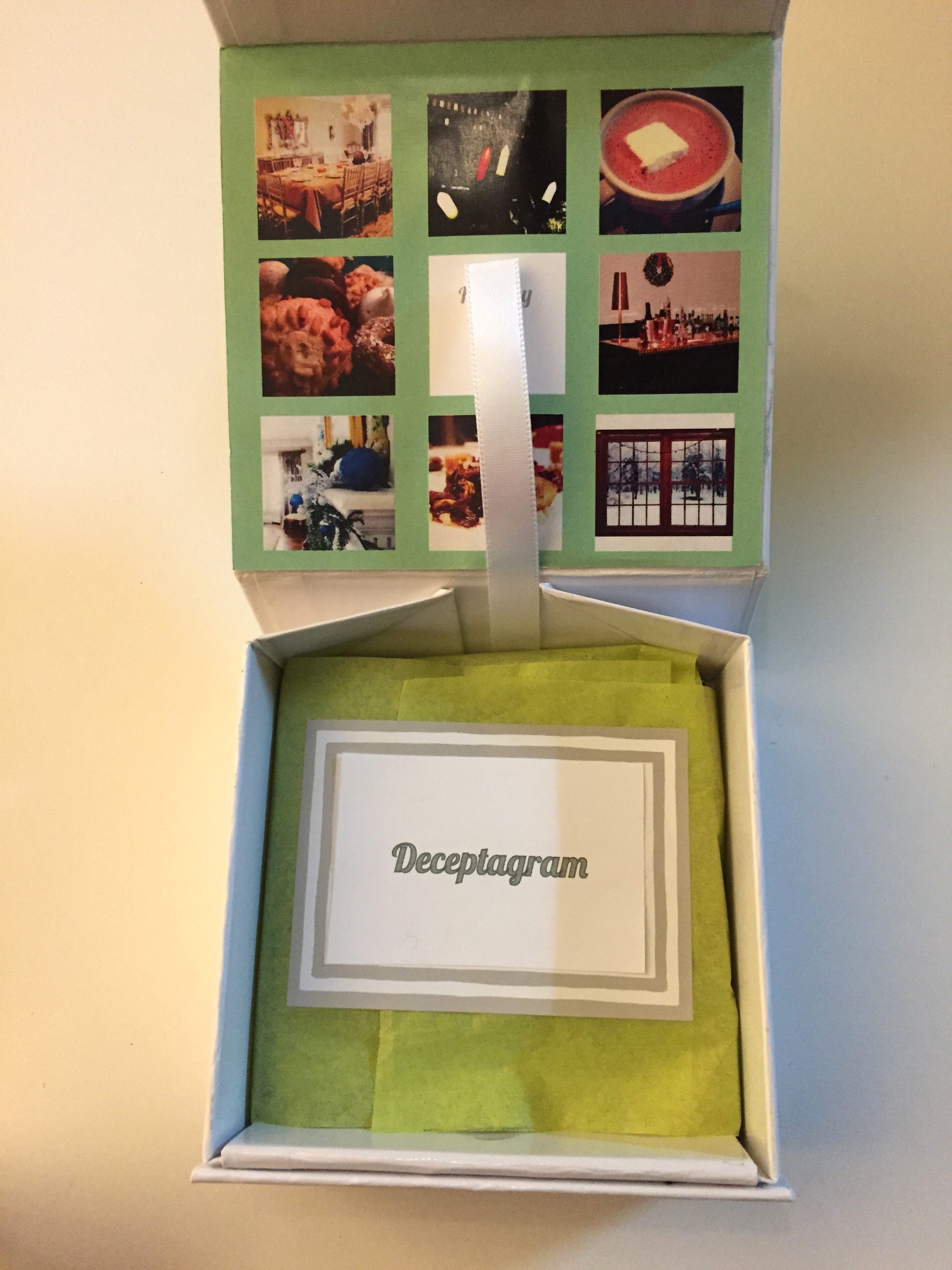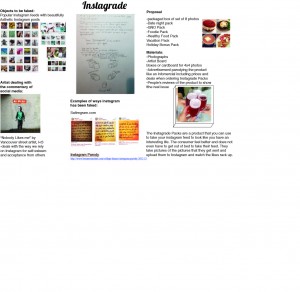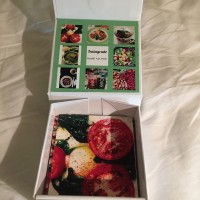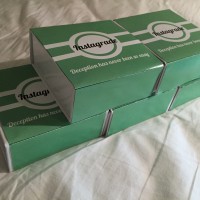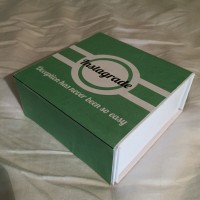Deceptagram Marketing and Rationale Presentation:
Marketing and Rationale Paper:
DECEPTAGRAM: MARKETING PLAN
Do you constantly scroll through your Instagram feed and ask yourself why your photographs can’t compare to cool girl’s or famous bloggers’? Do you feel like staying in bed, but still want to appear like you have an interesting life? Do you want to get more likes and followers and maintain a certain appearance for your followers through social media? Then “Deceptagram” is the perfect product for you. Our product consists of different packs of photographs that you order for delivery. Each pack consists of 8 photographs from a specific category. If you want to appear like a foodie, order the Foodie Pack. If you want to appear like you went on vacation, the Tropical Vacation Pack works perfectly for you. Our slogan “Deception has never been so easy” proves the point of the product. Each Deceptagram Pack will assist in easily deceiving followers to believe you lead an exciting life illustrated through false Instagrams. Consumers purchase the packs and receive physical photographs that they simply have to take a picture of and post. Caption ideas are included on the backs of the photographs and no picture is ever repeated so the consumer never has to worry that someone has the same Instagram post as them. The physical aspect of the photographs and the opening of the box that they are packaged in give the consumer a feeling of happiness, possession, and value as they unwrap their box of beautiful photographs. Just because the photograph is online, does not mean the consumer has to go without that special feeling of holding and owning a physical product.
The “Deceptagram” product is the newest form of technology that will turn the most basic Instagram profile into a hit. With this product, your Instagram photographs will be original and exciting, and create a strong portfolio of photos to call your own. Deceptagram is a company selling packs of eight photographs to be ordered and delivered. Once delivered, the consumer takes out the photographs and then takes a photograph of each 4” x 4” square photograph to upload. This mechanism ensures that no photographs are leaked online and that each set of photographs becomes the consumer’s own. Deceptagram helps loners to make it appear like they have an exciting life full of friends, significant others, and other aesthetic photographs ranging from the categories of food and friends to vacations and holidays.
Without even leaving the bed, the consumer can upload a photograph of a fancy brunch or a date night. Not only will the consumer feel better because of more “likes”, but also the consumer will also gain followers and finally feel like they can compare to today’s top bloggers and Instagrammers. The Deceptagram product ensures that the consumer’s Instagram profile will popularize because each pack of photographs sent out is carefully selected and edited, and even comes with a suggested caption so the consumer does not have to go out of the way to think for themselves. The product is a deal and comes with a bonus pack when the consumer purchases four packs together. Also the target consumer, which consists of women from the preteen to young adult age, will see the infomercial and web advertisements on social media sites like Facebook and during television shows that they are likely viewing. Our product boasts the best form of deception in today’s technology age with the slogan, “Deception has never been so easy,” because the consumer simply purchases the product, takes a quick photo and uploads it, and leave the rest to “Deceptagram”. The consumer is aware that they are deceiving their followers and themselves, but is willing to lie and deceive in order to fake their lives so they can feel better about themselves and compare to others. Deceitfulness is in the customer’s nature when it comes to social media and the product assists in this simple form of deception.
The target customer for “Deceptagram” is a female Instagram user ranging from the preteen to young adult age. This customer may feel that their Instagram feed is lacking and that they need more likes or followers. They may also feel that they need to pretend to be someone they are not by posting photographs to curate their life to appear as they want it to appear to followers. The target customer does not have the life that she wants to show, but she knows that exciting pictures posted on Instagram will lead people to think she has an interesting life. The consumer is smart in this way because more Instagram followers and likes lead to better self-acceptance, which means that gaining followers and likes is the key to happiness. The consumer may not want to leave bed that day, but she will still want to post pictures of a brunch. She may not have friends but wants to pretend like she had a fun Girls Night Out. The customer can pretend to go on a date night and her followers and friends will think she actually has a date. This consumer knows the smart way to fake her life and rack up her followers through deception. Lucky for her, she does not have to take the time out of her life to actually fake deceptive photos. The consumer’s only job is to take a picture of an original photo sent from Deceptagram and post it.
The “Deceptagram” product costs $19.99 for 1 pack and $25.99 for two packs. If you buy four packs, you get a “Holiday Bonus Pack” for free. Each pack of photographs has a quality of craftsmanship put into the photography, the editing, and the complimentary caption idea. The photographs are packaged to perfection with care and with the consumer in mind. Included in each package are a custom label, tissue paper, a magnetic container, and eight perfectly deceitful photographs. The company caters to those with the need to gain acceptance and feel loved, so we treat the consumer with this love. Each pack of 8 photographs costs about $10.99 to produce, which concludes that the total price of $19.99 per pack is a deal because each photograph costs about a $1.50 and the packaging costs about $5.00. The bonus pack is a special offer to get consumers to purchase four packs because if they like the program, they would likely buy multiple packs to gain an Instagram following and maintain it. Gaining followers leads consumers to feel the need to continue posting great pictures, so the need to purchase more Deceptagram packs increases as followers do. This direct correlation creates a demand for the product once a consumer engages in the service.
The marketing campaign will be done through Infomercials and web advertisements. This way, infomercials can reach people who watch certain television programs. For example, we can cater the advertisements to our target consumer by playing the infomercial during Pretty Little Liars or American Horror Story. Social media users frequently watch these television shows, evidently because they are some of the top shows tweeted about in 2014.[1] Because of the popularity of these shows in affiliation with social media, the ads would directly appeal to the same target consumer. Also, web advertisements can cater to targeted consumers that use Facebook and other social media sites. The people using social media are definitely going to be the consumers so this is the perfect place to advertise.
The sample ad would be an infomercial in which the product would be sold by the host and would be explained using actors. The actors would be teen or young adult women that would model how the product should be used and emphasize their feelings and change in attitude from before using the product to after using the product. This shift would show a positive change and they would feel better as the likes on their photographs add up.
DECEPTAGRAM: RATIONALE
In this age of Instagram and Facebook, people often deceive others about their lives through photos. Instagram users ranging from young preteens to adults follow fashion and food bloggers among many other Instagrammer that carefully curate their profiles containing photographs that make their lives seem like a virtual art show. The experiences people post on Instagram instill a jealousy in people, which creates a chain reaction. The people that have this envy then post their best pictures to make their lives seem equally as exciting and aesthetically pleasing. While many people post their best pictures and moments, they are deceiving people because their followers think it is part of their everyday life. In this way, Instagram has become a deceptive site in which users create fake profiles and attempt to appear like someone they are not. People even post fake pictures or take other peoples pictures to successfully boast their life and gain likes by using deception.
Through my product, I satirize the social phenomenon of the need to create a false image through Instagram. I also take into the account that “likes” are a main incentive that drives this need to feel acceptance and satirize the fact that “likes” improve self-esteem. “Viewers, meanwhile, are expected to let the sumptuous photos wash over them and chip in with comments (“Gorgeous sunset!”) and heart-shape “likes,” which function as a form of social currency, reinforcing the idea that every shot is a performance worthy of applause.”[2] These likes are an aspect of social media that drives people to pretend to be someone they are not through photographs. The need for acceptance and bragging one’s life through social media has never been easier with photographs and followers. “The result is an online culture where the ethic is impress, rather than confess.” [3] This idea of impressing one’s life upon others rather than showing reality has become a phenomenon that people are obsessed with. Preteens begin to use social media and immediately become enveloped in appearance and judgment. “For a young kid, clout comes in the form of a high number, which makes you look like you’re really important. It’s a more innocent and more straightforward way about getting the attention they’re craving.”[4] Instagram users starting at young ages use the site and feel important as they gain likes. This drives them further to want the perfectly curated photographs that will gain likes to further that feeling.
This phenomenon is dangerous and has created people to stop caring about reality and start caring more about how they are perceived by others. Maslow’s hierarchy of needs model states that esteem through status cannot be met until one is satisfied through love and belongingness of actual friendship. [5] Today, the virtual world is changing people’s perceptions because they disregard real friendships and think that likes and followers fill this void when they only help the person feel a heightened sense of status.
The “Deceptagram” product plays on the idea that people could be completely content with posting photographs onto their profiles that are not even their own. They did not have these experiences and did not take the photographs, yet they will still feel completely fulfilled because they will get likes and followers and will have a strong profile like the bloggers they scroll past everyday. The product also parodies Instagram because the app itself is a product that allows people to easily fake their lives and even promotes the sense of belongingness through media rather than reality.
I love Instagram and even have a food Instagram myself because I love visual images and follow many food and fashion bloggers. I do not like to fake my life, but I do like to choose aesthetic pictures because I am a visual person. Through my Instagram, I have seen several hashtags about #eatingfortheinsta in which the user implies they are eating solely to capture the image and Instagram their food. This type of comment sparked my idea that people are misusing the app and lead me to research further into the negatives of the social phenomenon where people are faking their lives through photographs on Instagram.
Bibliography
McLeod, Sam. “Maslow’s Hierarchy of Needs.” Simply Psychology. January 1, 2007. http://www.simplypsychology.org.
Moss, Caroline. “I Tried Using Instagram Like A Teenager – And It Completely Changed The Way I See The App.” Business Insider. June 11, 2014. http://www.businessinsider.com.
Williams, Alex. “The Agony of Instagram.” The New York Times. December 14, 2013. http://www.nytimes.com.
“The Digital Consumer Report 2014 Nielsen.” The Digital Consumer Report 2014 Nielsen. January 1, 2014. http://www.slideshare.net/tinhanhvy/the-digital-consumer-report-2014-nielsen.
1. “The Digital Consumer Report 2014 Nielsen.” The Digital Consumer Report 2014 Nielsen. January 1, 2014. http://www.slideshare.net/tinhanhvy/the-digital-consumer-report-2014-nielsen.
2. Williams, Alex. “The Agony of Instagram.” The New York Times. December 14, 2013. http://www.nytimes.com.
3. Ibid.
4. Moss, Caroline. “I Tried Using Instagram Like A Teenager – And It Completely Changed The Way I See The App.” Business Insider. June 11, 2014. http://www.businessinsider.com.
5. McLeod, Sam. “Maslow’s Hierarchy of Needs.” Simply Psychology. January 1, 2007. http://www.simplypsychology.org.
Presentation Board:
After creating the book project on the theme of food, I wanted to stay with the topic. I was thinking about food and Instagram because the two are relevant when combined in my life. I was inspired by the negatives of Instagram and how people use it to deceive others through documentation of their lives via images. Many people post images to get likes and feel better, but are not content on the inside. This deception is the focus of my project and my idea. Instead of just using food Instagrams for the product, I expanded into a variety of categories that people commonly use to deceive others and make them jealous. These topics include vacation , date night, holiday, and more.
My reference images include a street art piece dealing with a commentary on social media. It depicts a person said about getting no likes or followers on Instagram. This deals with the same issue that I satirize and shows the effects of the problem that social media has on its users. I also reference food Instagrams that acted as a source of my inspiration from my own life. Another source of inspiration was the Instagram feeds of famous bloggers I follow like SincerelyJules or AGuyNamedPatrick because they are professional bloggers with flawless Instagram feeds that many strive to match or mimic.
Preliminary “Instagrade” Packs:
As I created the product, I focused on creating a sleek packaging design and used all of my own photographs for each pack of photos. After the outside packaging, I created an inside packaging much like a table of contents so one can view the photographs that are in the pack without rummaging through the photos. From the preliminary Instagrade Packs, I changed the name to Deceptagram so it could encompass the feeling of deception that the packs really satirize. Also, I played around with different ways of executing a double-foodie pack by making a two-paneled table of contents for the inside packaging.
Final Deceptagram Product:
I ended up using a magnetic closure for the two-paneled inside packaging. Also, I created stickers for the inside packaging and cut the tissue paper so each pack could be individually wrapped like a gift. The last step was creating a pull up tab so the stacks of photographs could easily be pulled out of the box.
Deceptagram Display in Urban Outfitters:
